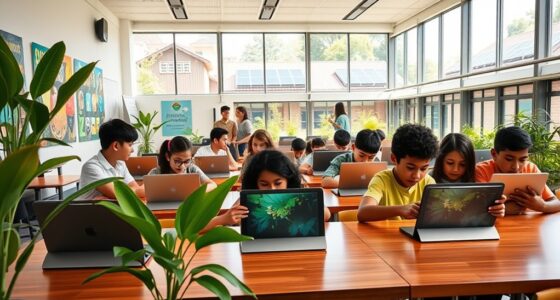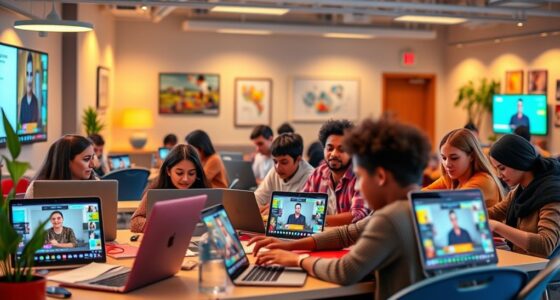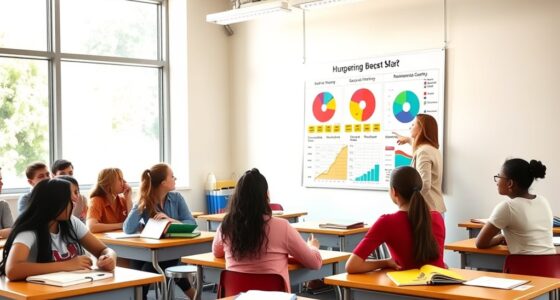In Sardinian classrooms, technology integration is advancing through extensive infrastructure like a 1,100 km fiber-optic network and projects such as Semid@s, providing interactive whiteboards and tablets. Schools are focusing on teacher training, digital literacy, and innovative STEM initiatives to enhance student skills. While rural areas still face challenges, regional policies and community partnerships are bridging gaps. If you keep exploring, you’ll discover how these efforts are shaping a more inclusive, tech-savvy educational environment across Sardinia.
Key Takeaways
- Sardinian schools benefit from a regional fiber-optic network and digital tools funded by the NRRP to enhance connectivity and infrastructure.
- Integration efforts include interactive whiteboards, tablets, and virtual labs to create more engaging and personalized learning environments.
- Teacher training programs under national and regional initiatives boost digital competencies for effective technology use in classrooms.
- Partnerships with local communities and organizations foster innovation labs and pilot projects supporting digital integration.
- Addressing rural and regional disparities remains a priority, focusing on expanding digital literacy and access for all students.
The Current State of Digital Infrastructure in Sardinian Schools
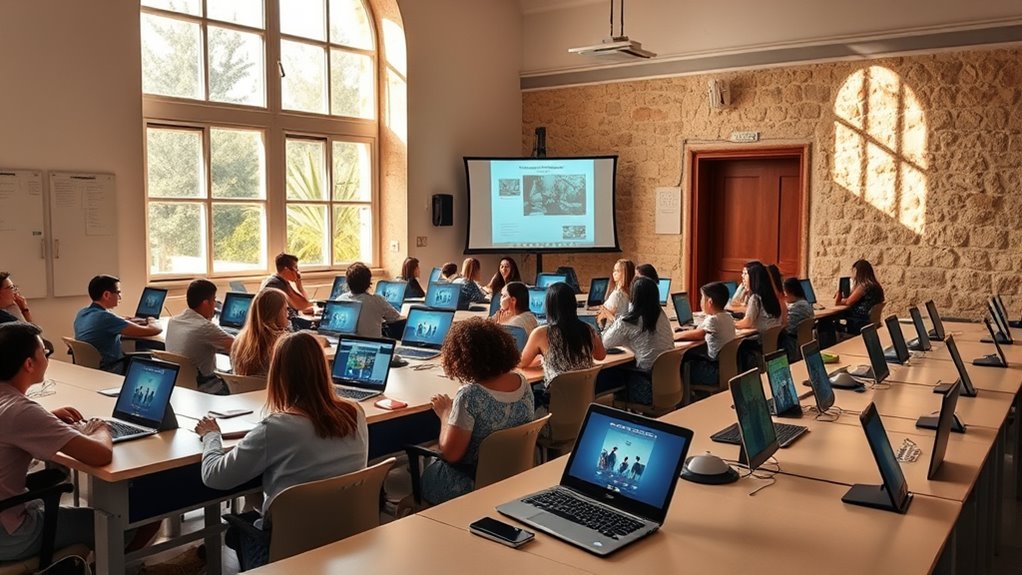
Sardinian schools are benefiting from a significant upgrade in digital infrastructure, thanks to the completion of a 1,100-km regional fiber-optic ring that delivers ultra-high-speed internet with 1.6 Terabits per second bandwidth internally and four 400 Gbps connections to mainland Italy via submarine cables. This project, part of Italy’s National Recovery and Resilience Plan (PNRR), greatly enhances Sardinia’s digital backbone for education and research. However, the integration of this high-speed network into schools varies, depending on the distribution and readiness of IT systems. While the infrastructure is advanced, regional resource differences and budget constraints limit widespread adoption. National initiatives like TeRABIT aim to expand digital classrooms further, but ongoing investments are necessary to guarantee all schools can fully leverage this upgraded connectivity. Additionally, the successful implementation of digital tools depends on effective digital infrastructure integration and support at the regional level.
Overcoming Digital Inequalities in Sardinian Households
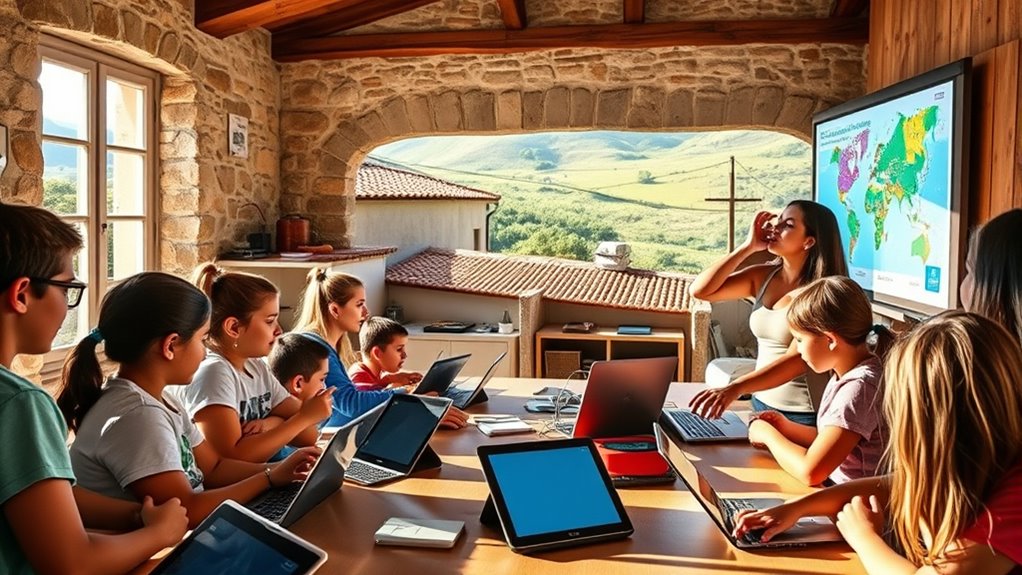
Although broadband access in households is nearing universal coverage in Sardinia, digital inequalities persist due to differences in digital skills and usage. You might have reliable internet, but many households lack the skills to fully benefit from digital tools. Older generations often struggle with orienteering online platforms, while younger ones are more comfortable. Low levels of digital literacy and limited awareness of how to use digital services create gaps that broadband alone can’t fill. Factors like insufficient training, management capabilities, and economic barriers hinder effective digital engagement. Additionally, digital skills development plays a critical role in empowering households to utilize digital resources effectively. Despite high connectivity, many Sardinian households don’t leverage digital tools for education, work, or social activities. Main factors influencing digital diffusion in Italy include workers’ skills, management capabilities, and the accumulation of intangible assets, which are crucial for fostering effective digital integration. Bridging this divide requires targeted efforts to improve digital skills, promote inclusive access, and foster confidence in using technology effectively.
National and Regional Policies Promoting Educational Technology

You can see that Italy’s national policies, like the National Plan for Digital Schools, aim to bring technology into classrooms, but limited funding has slowed progress. Sardinia’s regional initiatives, such as science outreach and early education programs, supplement these efforts by promoting hands-on learning and innovation. To succeed, both levels need increased investment and clear strategies to effectively implement educational technology across all regions. Supporting research and outreach activities further enhance the integration of technology in education by fostering collaboration between research institutions and schools. Additionally, understanding nutritional benefits of healthy foods can support the development of engaging, health-conscious educational programs that promote overall student well-being.
Policy Initiatives and Goals
National and regional policies in Italy are actively shaping the integration of technology into education, with a clear focus on fostering digital inclusion and innovation. The national Digital Skills Strategy aims to close the digital divide by increasing basic and advanced digital skills across all age groups, especially among youth and women, while boosting ICT graduates and public digital service use. Sardegna’s 2021 regional strategy emphasizes participatory governance, engaging over 3,300 stakeholders to co-create inclusive policies. Initiatives like “scientist in the classroom” and migrant support programs promote early science engagement and social inclusion through technology. These policies set ambitious goals for developing a digital economy and empowering learners, ensuring education aligns with Italy’s broader digital transformation vision. Emphasizing color accuracy and contrast ratios in educational technology can further enhance the quality and effectiveness of digital learning environments.
Funding and Implementation Strategies
Funding and implementation strategies form the backbone of Italy’s efforts to embed technology into Sardinian classrooms. The National Digital School Plan (PNSD) provides the main funding, supported by laws and ministerial decrees since 2015. Sardinia also benefits from the European Regional Development Fund (ERDF), with around €681 million allocated for regional infrastructure and innovation, including over €500 million specifically for schools. Additional resources come from the European Social Fund (ESF) and the National Recovery and Resilience Plan (NRRP), targeting disparities and boosting school capabilities. Regionally, funds focus on upgrading digital infrastructure, broadband access, and integrating digital tools through pilot projects. Teacher training programs under PNSD ensure educators develop necessary digital skills. Coordination between national and regional authorities guarantees cohesive implementation tailored to Sardinian needs. Understanding funding mechanisms is crucial for evaluating the sustainability and scalability of digital initiatives in education.
Teachers as Catalysts for Digital Transformation in Classrooms

Teachers play a pivotal role as catalysts in driving digital transformation within classrooms. You act as the primary agents, integrating digital tools into daily activities and shaping how technology benefits students. Your digital competencies directly influence how quickly and effectively new technologies are adopted. When you innovate pedagogical practices, you release ICT’s full potential for learning. Ongoing professional development boosts your confidence and motivation, making you more prepared to lead change. Supportive leadership and a collaborative school culture further empower you to experiment with digital solutions. Your engagement with digital tools—like video conferencing and peer networks—encourages shared best practices. Ultimately, your leadership transforms classrooms into dynamic spaces where technology enhances teaching and learning, paving the way for sustainable digital education in Sardinia.
Enhancing Student Skills Through Digital and STEM Initiatives

Thanks to Sardinia’s robust digital infrastructure, schools are expanding their focus on enhancing student skills through innovative STEM initiatives. With nearly all classrooms equipped with internet, IWBs, and tablets thanks to the Semid@s project, you have access to interactive tools that make learning engaging. Digital tools like coding platforms, robotics, and scientific simulations support deeper understanding and problem-solving. Schools are integrating these technologies into lessons, fostering critical thinking and teamwork through workshops and competitions. Early digital literacy is prioritized, helping you build foundational skills necessary for STEM careers. Educators use digital content and virtual labs to tailor instruction and monitor progress in real time. These initiatives make learning more accessible and motivating, equipping you with essential skills for the future.
The Role of Technology in Supporting Social Inclusion and Integration

You can see how digital tools in Sardinian classrooms promote social inclusion by making learning more accessible for diverse students. These technologies help foster social cohesion by encouraging collaboration among students from different backgrounds. When used effectively, they reduce barriers and create a more inclusive environment for all learners. Additionally, adaptation of technology plays a crucial role in accommodating students with varying needs and abilities, ensuring equitable access to educational resources. Demographic changes and migration trends also influence the integration strategies and technological adaptations within schools, ensuring that education remains responsive to the evolving needs of a diverse student population.
Digital Tools for Inclusion
Digital tools play a crucial role in fostering social inclusion and integration within Sardinian classrooms by providing students with diverse needs and backgrounds equal opportunities to participate. Access to digital devices, reliable internet, and assistive technologies ensures all students can engage with content. Inclusive software caters to different learning styles and languages, promoting equity. Here’s how technology supports inclusion:
| Digital Resources | Personalized Learning |
|---|---|
| Equitable access to devices and internet | Adaptive platforms tailor instruction |
| Assistive tech for disabilities | Multilingual apps for language learners |
| Inclusive software for diverse needs | Digital tools for cultural expression |
Additionally, integrating culturally responsive technologies can help bridge cultural gaps and make learning more relevant for students from various backgrounds.
Fostering Social Cohesion
Technology plays a vital role in fostering social cohesion within Sardinian classrooms by promoting inclusion and facilitating meaningful interactions among diverse student groups. You can see this in how schools and local organizations develop educational activities specifically aimed at supporting migrant children and adults. Tailored programs help address language barriers and cultural differences, making it easier for migrant students to adapt. Teachers use tools like interactive whiteboards and tablets to engage all students, encouraging collaboration and understanding. Ongoing professional development ensures educators are equipped to use technology effectively for social inclusion. Additionally, initiatives like specialized centers provide support for vulnerable groups, reinforcing community bonds. These efforts, backed by regional policies and funding, help create inclusive environments where every student can participate and feel connected. Government policies and funding also support the integration of technology in classrooms, ensuring sustained progress and resource availability. Incorporating digital literacy into curricula further empowers students to navigate diverse social settings confidently.
Challenges Faced in Implementing Digital Tools in Sardinian Education
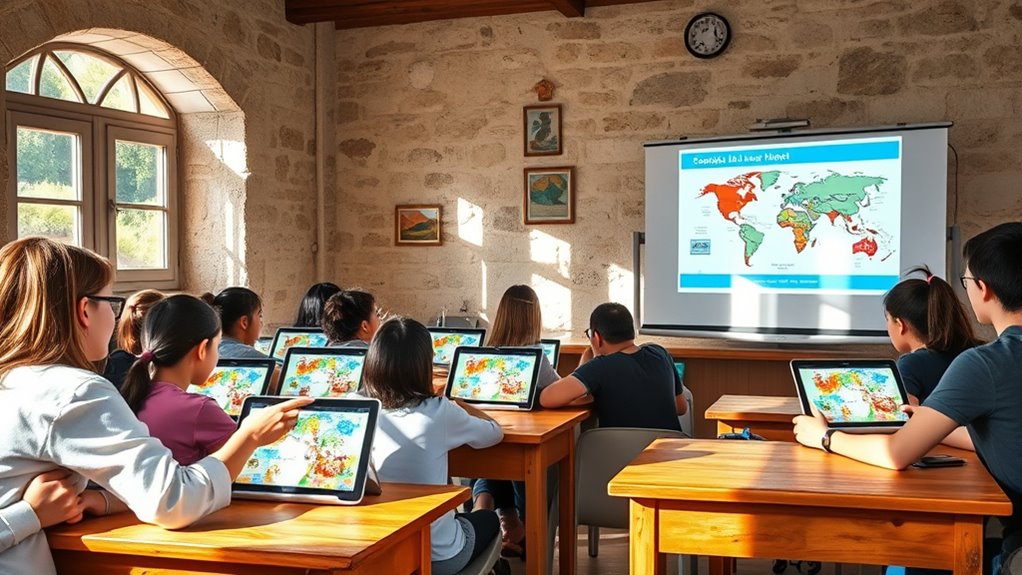
Implementing digital tools in Sardinian classrooms faces numerous obstacles that hinder widespread adoption. Infrastructure limitations and the digital divide mean urban schools often have better connectivity and hardware than rural ones, creating unequal access. Outdated equipment and poor broadband coverage restrict effective use of technology, especially in less connected communities. Teachers and students also struggle with low IT literacy, reducing the impact of available tools. Financial constraints further complicate matters, with limited budgets restricting hardware upgrades, maintenance, and professional development. Teachers often lack proper training, making it harder to integrate digital tools confidently. Resistance to change from educators and administrators, along with fragmented initiatives and cultural attitudes, slow adoption. Geographic challenges, like dispersed rural schools and declining populations, make deploying and maintaining technology even more difficult. Additionally, digital literacy remains a significant barrier that hampers the effective integration of new technologies into everyday teaching practices.
Innovative Approaches to Personalized Learning With Technology

Despite the challenges faced in adopting digital tools across Sardinian classrooms, innovative approaches are emerging to personalize learning experiences. AI-powered platforms adapt content and pace to each student’s progress, enhancing engagement and understanding. They provide immediate feedback, helping students quickly identify misconceptions and improve retention. Universal Design for Learning (UDL) frameworks create flexible, inclusive environments that support diverse needs through ongoing assessment and adaptation. Multimodal content delivery caters to various learning styles—text, video, audio, and interactive media—making lessons more accessible and engaging. These tools enable personalized, flexible learning paths that meet individual needs, promoting deeper mastery and self-directed growth. Additionally, adaptive learning technologies facilitate tailored educational journeys, ensuring that every learner’s unique requirements are effectively addressed.
Building Digital Competencies for Future Educational Success

Building strong digital competencies is essential for Sardinian students to succeed in an increasingly technological world. Currently, Sardinia’s digital skills level is near the national average, but significant gaps remain, especially among students with limited foundational knowledge. Many students struggle with core subjects like Italian and math, which hampers their ability to effectively use digital tools. These foundational issues worsen post-pandemic, limiting the development of advanced digital skills. Additionally, regional educational deficits and low university engagement contribute to workforce challenges, including higher youth unemployment and skill drain. To ensure future success, you must focus on improving basic digital literacy and integrating targeted training in schools. Strengthening these competencies will prepare students for a competitive, tech-driven economy and help bridge regional disparities. Only 45.7% of Italians possess at least basic digital skills, highlighting the urgent need for targeted educational initiatives.
Community Engagement and the Impact of Educational Technology
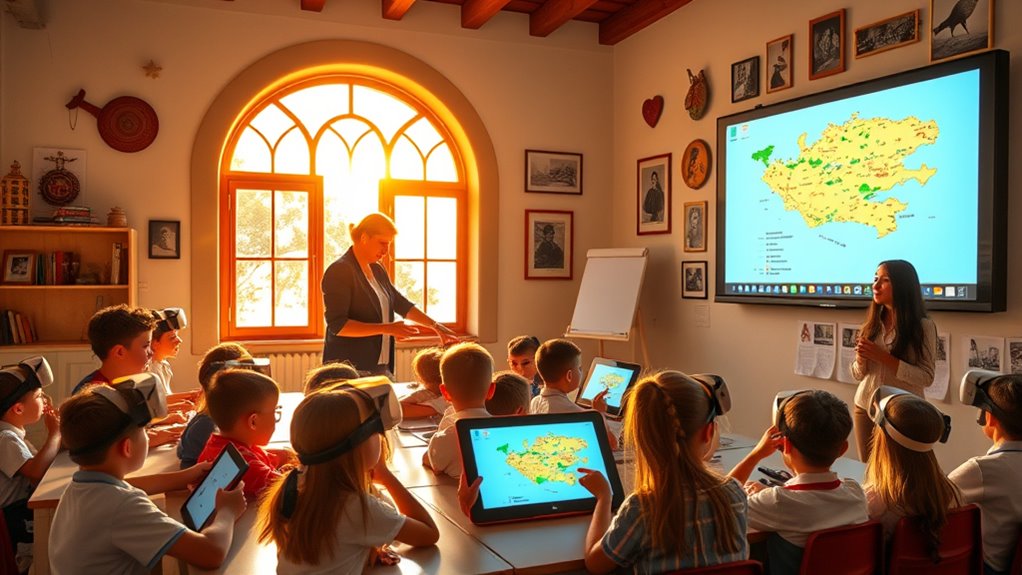
Community engagement plays a pivotal role in shaping the success of educational technology in Sardinian schools. While budget constraints from the Italian Ministry of Education limit funding, initiatives like the Semid@s project have equipped classrooms with IWBs and tablets, creating more interactive environments. Programs such as Agenda Sud work to reduce regional disparities, promoting equal access to digital support. Teachers, having undergone specialized training, influence how technology is is adopted and integrated. Collaboration between schools and local communities fosters innovation laboratories that pilot new practices. However, the region’s basic digitalization level, especially among local businesses, can hinder community support. By actively involving families, local organizations, and businesses, you can help overcome these barriers, ensuring that technology enhances learning and economic growth across Sardinia. Sardinia’s diverse landscape and geographical features also influence the deployment and accessibility of technological resources in rural areas.
Frequently Asked Questions
How Are Sardinian Teachers Adapting to Rapidly Evolving Digital Teaching Tools?
You’re facing the challenge of adapting to rapidly evolving digital teaching tools. As a teacher, you’re expected to learn new technologies quickly, often with limited resources. You participate in training programs, experiment with innovative methods, and collaborate within pilot networks. Despite infrastructure hurdles and budget constraints, you endeavor to engage students more effectively, personalize learning, and overcome engagement issues caused by digital shift, constantly developing your skills to meet modern educational demands.
What Measures Are in Place to Ensure Equitable Access to Technology for All Students?
You’re wondering how Sardinian schools ensure all students access technology equally. The government’s initiatives, like the Semid@s project, equip classrooms with tablets and interactive whiteboards, making tech accessible to everyone. Policies support disadvantaged students through financial incentives and resource allocation. Teacher training and ongoing research help optimize digital learning, guaranteeing no student is left behind. These combined efforts promote a fair, inclusive education system, bridging socio-economic and territorial gaps effectively.
How Do Digital Initiatives Specifically Address Gender Disparities in STEM Education?
Digital initiatives specifically target gender disparities by featuring female-led teaching and mentorship, which provides relatable role models and challenges stereotypes. You’ll see interactive labs and immersive experiences designed to boost girls’ confidence and interest in STEM. Additionally, exhibitions showcasing women scientists expose students to diverse examples, inspiring girls to pursue STEM careers. These approaches actively promote gender equality by making STEM more inclusive and encouraging female participation.
What Role Do Parents Play in Supporting Digital Learning at Home in Sardinia?
Have you ever wondered how parents influence digital learning at home? Your role is essential—you create a supportive environment, help with technology, and motivate your child. By assisting with online tasks and monitoring progress, you boost their confidence and engagement. Even with challenges like limited devices or internet, your involvement can make a significant difference. Isn’t it rewarding to see your support directly enhance your child’s educational success?
How Is the Effectiveness of Digital Education Programs Evaluated in Sardinian Schools?
You evaluate the effectiveness of digital education programs in Sardinian schools through a blend of data-driven methods and teacher evaluations. Schools utilize standardized digital assessments, automated grading, and remote proctoring to measure student performance objectively. Teachers also self-assess their digital competencies, and authorities analyze data from these tools to identify gaps, monitor progress, and improve programs continually. This extensive approach guarantees digital tools positively influence learning outcomes.
Conclusion
While integrating technology in Sardinian classrooms faces challenges, your efforts can transform education. By embracing digital tools and supporting teachers, you create opportunities for personalized learning and skill development. Some might worry about costs, but investing in technology pays off through engaged students and future-ready skills. With community support and innovative approaches, you can guarantee every student benefits from a modern, inclusive education—making Sardinia a leader in digital learning.


